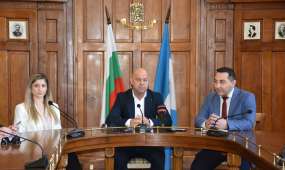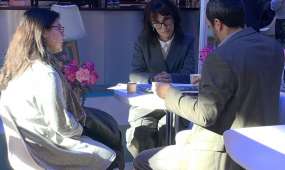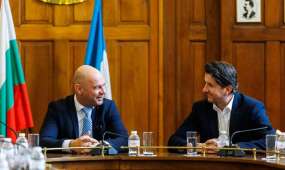Regional Ethnographic museum
phone: +359 32 625 654 email: [email protected] link: http://www.ethnograph.info/front/index.php?lng=enPlovdiv Regional Ethnographic museum is the second largest specialized museum of this type in Bulgaria. It is an acknowledged scientific-educational institution and an attractive center for cultural tourism. The museum was established in 1917 and since 1938 it has been located in Kuyumdzhieva house, a cultural monument of national significance. Plovdiv Regional Ethnographic museum provides coordinative, qualification and expert-consulting activities for all museums and collections of artifacts with ethnographic character on the territory of Plovdiv and the region. In addition, the museum lends its methodical support to the municipal and private museums.The museum is a co-organizer and a host of popular traditional festivals such as Festival the Annual Festival of Chamber Music, The Festival of Classic Guitar, etc., as well as concerts, biennials, fashion shows, theatrical plays, book presenting and performances. The demonstration of traditional crafts is another type of tourist attraction.
History
The idea of establishing an Ethnographic Museum dates back to the end of 1891. After a quarter of a century, based on the proposal of Stoyu Shishkov who was a teacher, researcher, journalist and publisher, the local administration decided on the establishment of a Regional museum. Its main aim is collecting materials concerning the past and the present of Plovdiv region viewed in historical, economic, artistic and everyday aspect. The museum started its existence on January, 22nd, 1917 when at the Municipal Council (at present Municipality of Plovdiv) a meeting was held and a decision was taken for “establishing a Regional museum run by a Standing committee”. The museum regulations were approved on July, 20th, the same year and according to them the first director was appointed Yordan PopGeorgiev and Stoyu N. Shishkov for a museum secretary.The years that followed were spent on collecting materials, taking pictures and promotion activities. In 1930 there were over 500 artifacts in the museum. In 1931- 1932, in spite of the well-grounded opposition of Stoyu Shishkov, the administration transferred this modest property to the Public Library and Museum, due to economy reasons. In 1938, following the initiative of the mayor Mr. Bozhidar Zdravkov, the Museum started its second existence: Kuyumdzhiev House, the most impressive house in Plovdiv, was appointed Municipal House Museum. On 14th October 1943, the new house of the Museum was opened for visitors. In 1949 the Municipal House Museum was renamed National Ethnographic Museum. In 1952 a permanent exhibition was introduced, totally renovated in 1962. Presently, over 40 000 artifacts are divided into the following six stocks: Agriculture, Crafts, Textiles and Clothing, Furniture and Interior, Musical Instruments and Ritual Properties, Works of Fine Art. There are also Photography, Scientific Archives and Library Sections.
The house
One of the most picturesque spots in the old town of Plovdiv is located near the eastern gate of the town called Hisar Kapiia (Hisar Stone Gate). As a part of this ensemble, the impressive façade of the Kuyumdzhiouglu house, built in the remote 1847 by the master-builder Hadji Georgi, creates unique atmosphere. It is a typical representative of Plovdiv Renaissance symmetrical house, defined by experts as a peak of Baroque architecture in Bulgaria. Its owner is Arghir Kuyumdzhiouglu, a wealthy tradesman from Plovdiv. Kuyumdzhieva house is a part of Architectural-archeological reserve The Ancient town of Plovdiv. The building has impressive size – four floors, each one with an area of 570 sq. m.; two big parlours; twelve rooms (all of them with unique wood-carved ceilings) and over one hundred and thirty windows. The focus is placed on the imposing reception parlour (hayet) on the second floor, arching and projecting above the wicket towards the yard. Characteristic of the reception parlour is its oval central part with a beautifully shaped wooden ceiling, constructed by means of a high painted chamfer. The eastern façade of the house was built upon the ancient fortified wall and is an inseparable part of the ensemble of Hisar Kapiia. At the end of 19th century the house became a girls’ boarding school, and later it turned into a millinery factory, a vinegar factory, and a storehouse for flour. Antonio Colaro, a tobacco tradesman, bought it in 1930. In 1938, following the initiative of the mayor Mr. Bozhidar Zdravkov, the Municipality of Plovdiv and the Ministry of National Education signed an official decision for establishing a Municipal House-Museum whose successor nowadays is Regional Ethnographic Museum in Plovdiv. Since 1943 the house-monument has been opened for visitors. Presently, the unique house is a National Monument of Culture.
Permanent exhibition
A museum is a place where one can see, touch and feel tradition. The rich collection represents the traditional culture of Thrace, the Rhodopes and the Sredna Gora mountains during the period of National Revival. On a permanent display, the agriculture and stock-breeding are presented as basic means of living of population in the region. One of the most characteristic crafts from the period of Renaissance are shown here: homespun and woolen braiding tailoring, pottery, coppersmith’s and ironsmith’s trade. The goldsmith’s workshop is represented by its entire inventory in the exquisite house. A great deal of adornment and religious items collection is exhibited, too. There is a separate place for national traditional costumes, textiles and carpets, musical instruments and ritual properties as well as urban style of living, frugally presented in the museum. The interiors of Koprivshtitza room, Rhodope room and Plovdiv drawing-room add to the information about the style of living and culture of the population in the region.
Agriculture
The Agriculture Stock comprises tools and utensils ( in total about 1000 inventory items) used in the economic activities of the population living in the region between the Rhodopes mountains and the Rose Valley. Exponents of the specific of this region: wine producing, tobacco-growing, rice-growing, rose oil manufacture, gardening and stock-breeding are displayed here. Among the exhibits, the following attract mostly visitors’ attention: a gun-powder box, dated 1757; wooden calendars (tallies), Rhodope bells, rose distillery in Karlovo (1876), etc.The stock is presented in two exhibit halls.
Crafts
The stock includes over 7 000 inventory items – craftsman’s articles and tools. The main collections are: copper utensils (one of the richest collections in our country, with samples from the middle of 18th c. until the end of 19th c.), porcelain, ceramics, wrought iron, adornments and church plates, clocks, antique arms, seals, and banners of craft-guilds.Four of the museum halls are separated for crafts to be displayed: homespun tailoring, pottery, copper-smithery and iron-smithery, and goldsmith’s trade.
Textiles and Clothing
With more than 11 000 exhibits, the Textiles and Clothing Stock is the largest one in the museum. The textiles are divided in two sections: small-size textiles (towels, tablecloths and small covers) and big-size textiles (carpets, rugs, goat’s hair rugs, felts, covers, tuft and fleecy rugs, fabrics for mattresses and quilts). There is a unique collection of carpets, dating back to the middle and the end of 19th century. The rich collection of traditional costumes and town suits represents not only the typical clothing from the region but such from all the other parts of the country, as well. Particularly interesting is the collection of underwear from the end of 19th c. and the beginning of 20th c. The stock comprises two exhibit halls and the second-floor parlour.
Furniture and Interior
The Furniture and Interior Stock contains over 800 artifacts, which date back to the beginning of 19th century until the middle of 20th century. The most valuable among them are the painted china plates, oil lamps, cast-iron and tile stoves, parlour and bedroom suits, painted chests and boxes.
The majority of the furniture is situated in three halls: a drawing room of a wealthy Plovdiv family from the end of 19th century, a Koprivshtitza and a Rhodope room. The refined tables, chairs, sofas, and armchairs in the two parlours add to the exhibition and create variety and coziness in it.
Musical Instruments and Ritual Properties
There are 5 400 exhibits preserved in this stock. The main collections are: gramophones and gramophone records, shepherd’s pipes, martenitsa (twined tasselled red and white thread, symbol of spring and health), and Easter eggs. The phonograph from the first Plovdiv Fair, the street organs, the pianos, the gramophones (some of them dating back to the beginning of 20th c.) together with the gramophone records represent the urban culture of the past century. Besides, the stock has a variety of folk musical instruments from the region available such as bagpipes, wooden pipes, shepherd’s pipes, rebecs, ocarinas, drums.The stock also includes most of the personal archives of the renowned Bulgarian musician, orchestra conductor and musicologist Angel Boukureshtliev. This is the place where one can see the harmonium owned by Naiden Gerov from the early 1960s of 19th century. It was the first keyboard musical instrument delivered to Plovdiv for fashionable use. The stock is presented in one exhibit hall.
Photo Gallery and Fine Art
The Fine Art Collection of the Ethnographic Museum consists of more than 100 valuable paintings, icons, statuettes, woodcarvings and metal figures. Authors’ names include painters like Simeon Velkov, Kosta Forev, Georgi Bozhilov – Slona, Dimitar Kirov, Kolyu Vitkovski, etc.With its more than 2000 inventory items, the photo gallery possesses a great information potential of a subject to scientific interpretations and a source of illustration of the life in Plovdiv and Plovdiv region – portraits, clothes, architecture, style of living, festive rites, etc. Most of the photographs are black and white, mounted, and date back to the beginning of 20th century. Their authors were some of the most famous photographers of that time: K. Savov, D. Kotsev, A. Kolarov, A. Tomov, etc. The exhibition includes the unique painting by Ivan Murkvichka “Market in Plovdiv” (1888), which was one of the first to depict everyday life of the Bulgarian town after the Liberation.
Day for free visit: Every first Thursday of the month for students and retired people.
The museum receives visitors in compliance with the anti-epidemic measures: http://www.ethnograph.info/front/news.php










